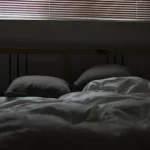- Sleep paralysis is a phenomenon where individuals wake up or fall asleep but are unable to move, often accompanied by vivid hallucinations and a feeling of suffocation.
- Hallucinations during sleep paralysis are believed to be a result of the blurred boundaries between sleep and wakefulness, where the brain generates dream-like imagery that feels real.
- Sleep paralysis can have a significant impact on daily life, causing exhaustion, sleep disturbances, anxiety disorders, and feelings of isolation.
- Coping strategies for sleep paralysis include improving sleep hygiene, reducing stress and anxiety, sleeping on your side, seeking support from others who have experienced it, and consulting with a healthcare professional.
Have you ever experienced the terrifying sensation of waking up but being unable to move your body? If so, you may have experienced sleep paralysis. Sleep paralysis is a phenomenon that occurs when you regain consciousness during the transition between sleep and wakefulness, but your muscles remain temporarily paralyzed. In this article, we will delve deeper into the world of sleep paralysis, exploring its relationship with the sleep stage cycle, the breakdown of the rapid eye movement (REM) cycle, the connection between sleep paralysis and muscle atonia, and more.
Detailed Explanation of Sleep Paralysis
1. Exploring the Sleep Stage Cycle
To understand sleep paralysis, we first need to understand the sleep stage cycle. When we sleep, our bodies go through different stages of sleep, including non-rapid eye movement (NREM) sleep and rapid eye movement (REM) sleep. NREM sleep has different stages, with the deepest stage known as slow-wave sleep (SWS). During SWS, our bodies repair and regenerate, and dreaming is rare. REM sleep, on the other hand, is a stage characterized by rapid eye movements, vivid dreaming, and temporary muscle [1] paralysis.
2. Breakdown of the Rapid Eye Movement (REM) Cycle
REM sleep is a fascinating stage of sleep where most of our dreaming occurs. During REM sleep, our brain activity resembles that of being awake, while our muscles are temporarily paralyzed to prevent us from acting out our dreams. This muscle paralysis, known as muscle atonia, is a protective mechanism that allows us to experience dreams without physical movement. However, when we regain consciousness during the REM cycle, this muscle atonia persists, resulting in sleep paralysis.
3. Relationship between Sleep Paralysis and Muscle Atonia
Sleep paralysis is closely linked to muscle atonia during REM sleep. Normally, when we transition from REM sleep to wakefulness, the muscle paralysis subsides, and we regain control of our bodies. However, in the case of sleep paralysis, this muscle atonia continues, leaving us temporarily unable to move or speak. It’s important to note that while sleep paralysis may make you feel vulnerable, it is a natural and harmless occurrence.
4. The Role of Hallucinations in Sleep Paralysis
One of the most distressing aspects of sleep paralysis is the accompanying hallucinations. During sleep paralysis episodes, individuals often report vivid hallucinations that are distinct from dreams. These hallucinations can be of different types, including intruder hallucinations, where the person perceives a dangerous presence in the room, or chest pressure hallucinations, which create a sensation of suffocation or the feeling of someone sitting on their chest. These hallucinations, combined with the paralysis, can intensify the fear and panic experienced during sleep paralysis.
5. Factors Contributing to Sleep Paralysis
While the exact cause of sleep paralysis is unknown, several factors have been associated with its occurrence. Sleep disorders, such as narcolepsy and sleep apnea, have been found to increase the risk of sleep paralysis. Disrupted sleep patterns, stress, and sleep deprivation can also contribute to the frequency and severity of sleep paralysis episodes. Additionally, certain mental health conditions, including anxiety disorders and post-traumatic stress disorder (PTSD), have been linked to sleep paralysis.
6. Managing and Preventing Sleep Paralysis
Although sleep paralysis can be a distressing experience, there are ways to manage and prevent its occurrence. Improving sleep hygiene, which includes maintaining a regular sleep schedule, creating a comfortable sleep environment, and practicing relaxation techniques before bedtime, can help minimize the risk of sleep paralysis. Managing stress and getting enough restful sleep are also important in reducing the likelihood of experiencing sleep paralysis.
7. Seeking Support and Professional Help
If you frequently experience sleep paralysis and it significantly affects your quality of life, it may be helpful to seek support from a healthcare professional. They can provide further evaluation and guidance tailored to your specific situation. Remember, you are not alone, and there are resources available to help manage and cope with sleep paralysis.
Factors Contributing to Sleep Paralysis

Sleep paralysis is a perplexing phenomenon that can be both distressing and frightening. While the exact cause of sleep paralysis is still not fully understood, researchers have identified several factors that contribute to its occurrence. In this section, we will explore some of these factors in depth.
1. Role of Genes in Sleep Paralysis
Research suggests that there may be a genetic component to sleep paralysis. Studies have found that individuals with a family history of sleep paralysis are at a higher risk of experiencing it themselves. However, no specific genes have been identified as directly responsible for sleep paralysis.
It is important to note that having a genetic predisposition does not guarantee the development of sleep paralysis. It simply means that there may be a higher likelihood of experiencing it. Other factors, such as sleep disorders or mental health conditions, may interact with genetic factors to contribute to sleep paralysis.
2. Impact of Mental Health Conditions
Mental health conditions, such as anxiety disorders and post-traumatic stress disorder (PTSD), have been linked to an increased risk of sleep paralysis. The relationship between mental health and sleep paralysis is complex and bidirectional. While sleep paralysis can cause distress and anxiety, pre-existing mental health conditions can also contribute to the occurrence of sleep paralysis episodes.
Individuals with anxiety disorders may experience heightened levels of stress, which can disrupt their sleep and increase the likelihood of sleep paralysis. Similarly, individuals with PTSD may be more prone to experiencing sleep disturbances, including sleep paralysis.
3. Sleep Disorders and Sleep Deprivation
Sleep disorders, such as narcolepsy and sleep apnea, are frequently associated with sleep paralysis. Narcolepsy, a neurological disorder characterized by excessive daytime sleepiness, often co-occurs with sleep paralysis. The disrupted sleep-wake cycles in narcolepsy can lead to episodes of sleep paralysis during the transitions between wakefulness and REM sleep.
Obstructive sleep apnea (OSA), a sleep disorder characterized by repeated pauses in breathing during sleep, has also been linked to sleep paralysis. The fragmented sleep patterns and oxygen deprivation associated with OSA can disrupt the normal sleep cycles, increasing the risk of sleep [2] paralysis.
Moreover, sleep deprivation itself can increase the likelihood of sleep paralysis episodes. A lack of quality sleep or consistently not getting enough hours of sleep can disturb the balance of sleep stages and make individuals more susceptible to sleep paralysis.
4. Sleep Position and Environment
Sleep position and environmental factors can also contribute to the occurrence of sleep paralysis episodes. Sleeping on your back has been associated with a higher risk of sleep paralysis. This position may increase the likelihood of experiencing muscle atonia and hallucinations during sleep transitions.
Environmental factors, such as noise or light disturbances, can disrupt sleep and contribute to the occurrence of sleep paralysis. Creating a sleep-friendly environment, including a dark and quiet bedroom, can help reduce the impact of these factors.
5. Stress and Emotional Distress
Stress and emotional distress have been identified as significant contributors to sleep paralysis. High levels of stress can disrupt the normal sleep patterns and increase the risk of experiencing sleep paralysis episodes. Emotional distress, such as trauma or anxiety, can also trigger sleep disturbances and episodes of sleep paralysis.
Managing stress and practicing relaxation techniques can help reduce the likelihood of sleep paralysis. Engaging in activities that promote emotional well-being, such as therapy or mindfulness practices, may also be beneficial in managing sleep paralysis.
6. Other Potential Factors
While the factors mentioned above have been extensively studied and associated with sleep paralysis, there may be other individual-specific factors that contribute to the occurrence of sleep paralysis. These factors can vary from person to person and may include lifestyle choices, medication use, or even specific sleep-related habits.
It is important to note that sleep paralysis is a complex phenomenon with multiple contributing factors. Identifying and understanding these factors can help individuals better manage their sleep and reduce the likelihood of experiencing sleep paralysis episodes.
In the next section, we will delve into the impact of sleep paralysis on individuals and explore potential treatment options. Stay tuned!
Key Takeaways:
- Sleep paralysis can be influenced by various factors, including genetics, mental health conditions, sleep disorders, sleep position, stress, and emotional distress.
- There may be a genetic predisposition to sleep paralysis, but no specific genes have been identified as the sole cause.
- Mental health conditions, such as anxiety disorders and PTSD, have been associated with an increased risk of sleep paralysis.
- Sleep disorders, such as narcolepsy and sleep apnea, can disrupt sleep cycles and contribute to the occurrence of sleep paralysis episodes.
- Sleep position, environmental factors, stress, and emotional distress can also impact the likelihood of experiencing sleep paralysis.
Diagnosing Sleep Paralysis

Sleep paralysis is a common and unsettling condition that can cause temporary loss of muscle function while waking up or falling asleep. If you’ve been experiencing episodes of sleep paralysis, it’s helpful to understand how it can be diagnosed and what steps you can take to manage it. In this section, we’ll explore the assessment process for sleep paralysis and the use of overnight sleep studies and multiple sleep latency tests for diagnosis.
1. Assessment Process for Sleep Paralysis
When you visit a healthcare provider to discuss your symptoms of sleep paralysis, they will start by conducting a thorough assessment. This assessment may include the following:
Medical History
Your healthcare provider will ask you about your medical history, including any sleep disorders you may have or any underlying medical conditions that could be contributing to your symptoms. They may also inquire about any medications you are taking that could potentially affect your sleep.
Sleep Diary
To gain a better understanding of your sleep patterns and the frequency of your sleep paralysis episodes, your healthcare provider may ask you to keep a sleep diary. This diary will require you to document information such as the time you go to bed, the time you wake up, and any unusual sleep-related experiences you have throughout the night.
Symptoms and Episode Details
Your healthcare provider will want to know more about your symptoms and the specific details of your sleep paralysis episodes. They may inquire about the duration of each episode, any accompanying sensations or hallucinations, and whether you are able to recall the episode afterwards. Sharing this information will help them determine if your symptoms align with sleep paralysis.
Mental Health Evaluation
In some cases, sleep paralysis can be associated with mental health conditions such as anxiety or depression. Your healthcare provider may conduct a mental health evaluation to assess your emotional well-being and determine if there are any underlying psychological factors contributing to your sleep paralysis.
2. Use of Overnight Sleep Studies
In certain cases, your healthcare provider may recommend an overnight sleep study, also known as a polysomnography, to diagnose sleep paralysis. During this study, you will spend a night in a sleep laboratory where your sleep patterns will be monitored.
Electrodes and Sensors
Electrodes and sensors will be placed on various parts of your body, such as your scalp, face, chest, and legs. These electrodes will measure your brain waves, eye movements, muscle activity, and heart rate throughout the night. Sensors will also be used to monitor your breathing patterns and oxygen levels.
Observation and Recording
While you sleep, healthcare professionals will observe and record your sleep data. They will be looking for patterns that may indicate episodes of sleep paralysis, such as abnormal muscle activity during the transition between wakefulness and sleep. This data will help them make an accurate diagnosis.
Multiple Sleep Latency Test (MSLT)
In some cases, your healthcare provider may also recommend a multiple sleep latency test (MSLT) to assess your daytime sleepiness. This test involves taking several short naps throughout the day while your brain activity and sleep patterns are monitored. It can help determine if your sleepiness is due to narcolepsy or another related condition.
3. Management and Treatment Options
Once a diagnosis of sleep paralysis has been made, your healthcare provider will work with you to develop a management and treatment plan. The goal of treatment is to reduce the frequency and severity of your sleep paralysis episodes and improve your overall sleep quality.
Sleep Hygiene
Improving your sleep hygiene is often the first step in managing sleep paralysis. This involves creating a consistent sleep schedule, practicing relaxation techniques before bed, and creating a sleep environment that is comfortable and free from distractions.
Stress Reduction
Reducing stress in your life can have a positive impact on your sleep patterns. By finding healthy ways to manage stress, such as through exercise, therapy, or relaxation techniques, you may be able to reduce the frequency of your sleep paralysis episodes.
Medications
In some cases, medication may be prescribed to help manage sleep paralysis. Medications such as stimulants or selective serotonin reuptake inhibitors (SSRIs) may be prescribed to address underlying sleep disorders, such as narcolepsy or the anxiety and depression often associated with sleep [2] paralysis.
Cognitive Behavioral Therapy
Cognitive behavioral therapy (CBT) can be an effective tool for managing sleep paralysis. This type of therapy focuses on identifying and changing negative thoughts and behaviors that contribute to sleep problems. CBT can help you develop healthier sleep habits and cope with the fear and anxiety that often accompany sleep paralysis.
4. Final Thoughts
Being able to diagnose and manage sleep paralysis is an important step towards improving your quality of life and sleep. By working closely with your healthcare provider and following their recommendations, you can develop a personalized treatment plan that addresses your specific needs. Remember, you’re not alone in this experience, and there are strategies and resources available to help you navigate sleep paralysis.
Managing and Preventing Sleep Paralysis
If you’ve ever experienced sleep paralysis, you know how scary and unsettling it can be. The feeling of being awake but unable to move or speak can leave you feeling helpless and panicked. But there are ways to manage and prevent sleep paralysis so that you can get a restful night’s sleep. [2] In this article, we’ll explore some potential treatment options, discuss the importance of good sleep habits, address underlying conditions, and delve into the role of self-care and health consultations.
1. Potential Treatment Options for Sleep Paralysis
While there is no proven cure for sleep paralysis, there are treatment options that can help reduce the frequency and severity of episodes. One potential approach is cognitive-behavioral therapy (CBT), which focuses on identifying and changing negative thought patterns and behaviors that may contribute to sleep paralysis. CBT can help you reframe your thoughts about sleep paralysis and develop coping strategies to manage the fear and anxiety associated with it.
Another option is medication, which can help regulate your sleep cycles and reduce the likelihood of experiencing sleep paralysis. Your healthcare provider may prescribe antidepressants or other medications that can suppress REM sleep, during which sleep paralysis most commonly occurs. However, it’s important to discuss the potential benefits and downsides of medication with your doctor, as some medications can have side effects and may not be suitable for everyone.
In addition to therapy and medication, improving your sleep hygiene can also be beneficial in managing sleep paralysis. This includes establishing a regular sleep schedule, creating a comfortable sleep environment that is free from distractions, and practicing relaxation techniques before bed. Avoiding caffeine and alcohol, especially in the evening, can also help improve sleep quality and reduce the likelihood of sleep paralysis episodes.
2. Importance of Good Sleep Habits
Maintaining good sleep habits is crucial for managing sleep paralysis. Consistency is key when it comes to your sleep schedule. Try to go to bed and wake up at the same time every day, even on weekends. This helps regulate your body’s internal clock and promotes a more restful sleep.
Creating a sleep-friendly environment can also make a big difference. Make sure your bedroom is quiet, dark, and at a comfortable temperature. Invest in a supportive mattress and pillows that promote proper sleep posture. Minimize exposure to electronics, such as smartphones and tablets, before bed, as the blue light emitted by these devices can interfere with your sleep cycle.
3. Addressing Underlying Conditions
Sleep paralysis is often associated with underlying sleep disorders, such as narcolepsy or sleep apnea. If you suspect that an underlying condition is contributing to your episodes of sleep paralysis, it’s essential to seek medical attention and get a proper diagnosis. Treating these conditions can help alleviate symptoms and reduce the occurrence of sleep paralysis.
If you suspect that you may have narcolepsy, characterized by excessive daytime sleepiness and uncontrollable bouts of sleep, consult with a sleep specialist. They can perform tests, such as an overnight sleep study or a multiple sleep latency test, to evaluate your sleep architecture and identify any underlying sleep disorders.
In the case of sleep apnea, a condition characterized by episodes of paused or shallow breathing during sleep, treatment options may include lifestyle changes, such as weight loss and avoiding alcohol before bed, as well as the use of a continuous positive airway pressure (CPAP) machine to help keep your airways open during sleep.
4. The Role of Self-Care and Health Consultations
Self-care practices can play a significant role in managing and preventing sleep paralysis. Prioritizing good sleep hygiene is an essential part of self-care. Take time to wind down before bed with relaxing activities, such as reading a book or taking a warm bath. Avoid engaging in stimulating activities or consuming caffeine close to bedtime.
If you experience sleep paralysis, remind yourself that it is a temporary condition and that you are not in any physical danger. Practice deep breathing or relaxation exercises to help calm your mind and body during episodes. It may also be helpful to keep a journal to track patterns or triggers for sleep paralysis, as this can assist you in identifying potential solutions or lifestyle adjustments.
In addition to self-care practices, seeking out professional help is crucial for managing sleep paralysis. Consult with a healthcare provider, such as a sleep specialist or therapist, to discuss your symptoms and develop a comprehensive treatment plan tailored to your individual needs. They can provide guidance, support, and resources to help you better understand and cope with sleep paralysis.
The Frightening Experience of Sleep Paralysis
Sleep paralysis is a terrifying phenomenon that can leave individuals feeling helpless and frightened. It is a temporary loss of muscle control that occurs just after falling asleep or before waking up, and it often involves vivid hallucinations and a sense of suffocation. This article will explore the various aspects of sleep paralysis, including the explanation of hallucinations, the impact it has on daily life, the psychological and emotional consequences, and coping strategies for those who experience it.
1. Explaining Hallucinations in Sleep Paralysis
One of the most distressing aspects of sleep paralysis is the presence of hallucinations. Many individuals report seeing or hearing unsettling things during episodes, such as shadowy figures, intruders, or menacing entities. These hallucinations can feel incredibly real and can intensify the sense of fear and helplessness.
The prevailing theory behind these hallucinations is that they stem from the blurred boundaries between sleep and wakefulness. During sleep paralysis, the brain is in a mixed state of consciousness, combining elements of both sleep and wakefulness. This can lead to the brain generating dream-like imagery that individuals perceive as real, even though they are awake and unable to move. [3]
2. Impact of Sleep Paralysis on Daily Life
Sleep paralysis can significantly impact a person’s daily life. Episodes of sleep paralysis often leave individuals feeling exhausted and fatigued the following day. The fear and anxiety associated with the experience can also lead to sleep disturbances, making it difficult for individuals to get restful and rejuvenating sleep.
In addition to the physical toll, sleep paralysis can also affect a person’s mental well-being. The fear and helplessness experienced during episodes can lead to increased anxiety and even the development of anxiety disorders. Individuals may become anxious about falling asleep, which can disrupt their sleep patterns and perpetuate the cycle of sleep paralysis.
3. Psychological and Emotional Consequences
The psychological and emotional consequences of sleep paralysis can be significant. The fear and terror experienced during sleep paralysis episodes can lead to feelings of dread and anxiety about going to sleep. This can create a vicious cycle of sleep deprivation and heightened anxiety, impacting overall mental health and well-being.
Sleep paralysis can also lead to feelings of isolation and alienation. Many individuals who experience sleep paralysis feel misunderstood and alone, as it is often difficult to describe the sensations and fear associated with the phenomenon. Finding support from others who have experienced similar episodes can be incredibly helpful in coping with the psychological and emotional consequences of sleep paralysis.
4. Coping Strategies for Sleep Paralysis
While there is no cure for sleep paralysis, there are several strategies that individuals can utilize to cope with and reduce the frequency of episodes. Here are some tips for managing sleep paralysis:
- Improve sleep hygiene
Establish a consistent sleep schedule, create a relaxing bedtime routine, and make your sleep environment comfortable and conducive to restful sleep. - Reduce stress and anxiety
Engage in stress-reducing activities such as meditation, deep breathing exercises, or journaling before bed to promote relaxation and calmness. - Sleep on your side
Some studies suggest that sleeping on your side instead of your back may reduce the likelihood of experiencing sleep paralysis. - Seek support
Connect with others who have experienced sleep paralysis through support groups or online forums. Sharing your experiences and hearing from others can provide a sense of validation and relief. - Talk to a healthcare professional
If sleep paralysis is negatively impacting your daily life, it may be beneficial to speak with a healthcare professional or sleep specialist. They can offer guidance, recommend treatments or therapies, and help address any underlying sleep disorders that may be contributing to the episodes.
You are not alone in your experience with sleep paralysis. By implementing these coping strategies and seeking support, you can navigate the challenges of sleep paralysis and find ways to improve your overall sleep quality and well-being.
If you experience sleep paralysis, you are not alone. It’s estimated that up to 8% of people experience this phenomenon at least once in their lifetime. It can be a frightening and unsettling experience, so it’s important to seek support and try to understand what triggers your episodes. With small changes in lifestyle and seeking help from professionals, you can manage sleep paralysis and lead a healthy, normal life. Remember to prioritize your sleep hygiene, manage your stress and anxiety, and seek support when you need it. Take care of yourself, and don’t hesitate to reach out for help if you need it.
References
[1] Sleep Paralysis – StatPearls – NCBI Bookshelf
[2] Sleep Paralysis: Causes, Symptoms, Treatment, and …
[3] Sleep Paralysis: ‘A Really Scary Experience’ – CBS Chicago










Leave a Reply